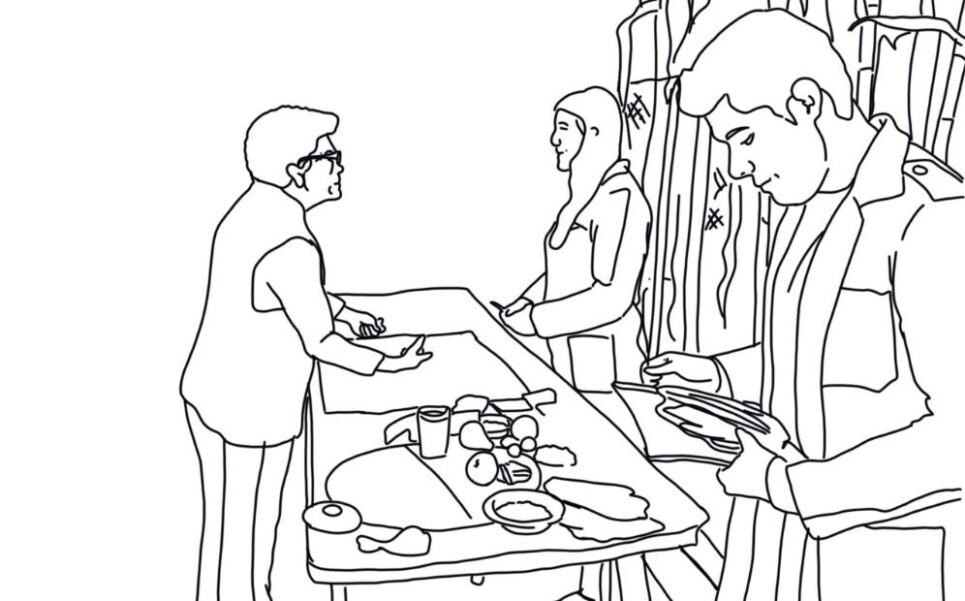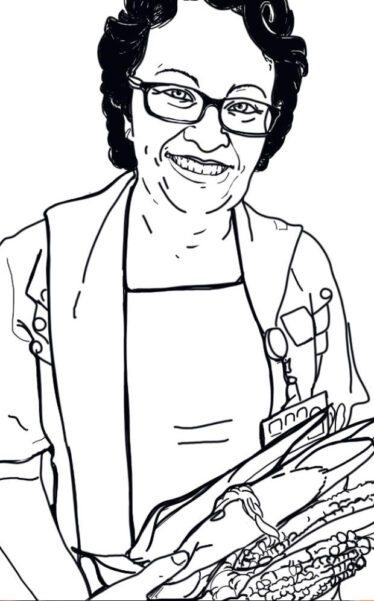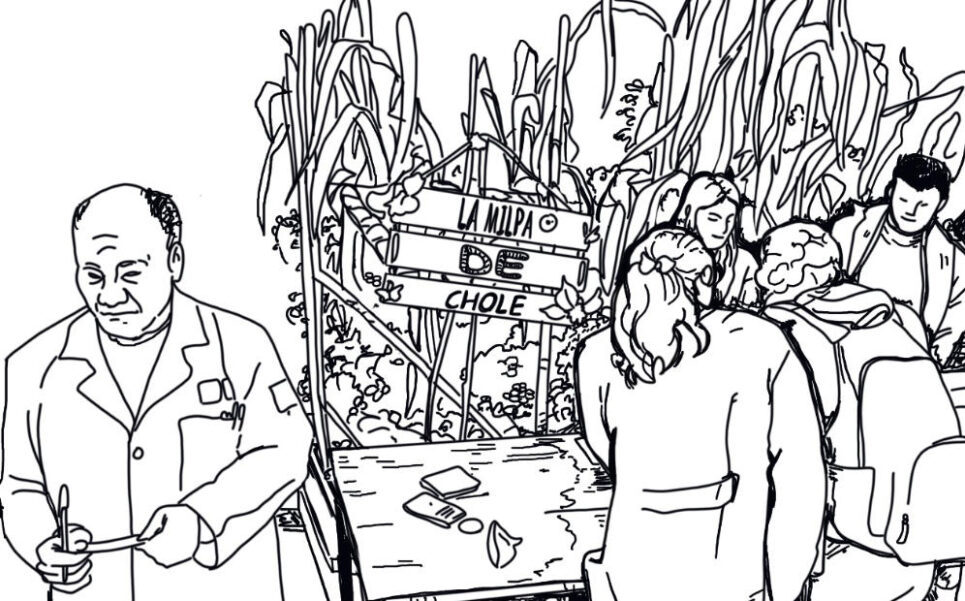The milpa is an ancient agricultural system originating in Mesoamerica, in what we now know as Mexico. Within it, three central elements create a synergy that enhances the individual properties of each and keeps the soil nourished: corn serves as a guide for beans, which provide nitrogen to the entire milpa, while the leaves of the squash keep the soil moist by covering the ground and preventing the evaporation of rainwater.
Around the milpa, edible greens known as *quelites* are planted. These nutrient-dense plants are rich in minerals, vitamins, and proteins, making them superfoods—foods with exceptionally high nutritional value.
The distribution of the milpa is strategically adapted to the territory, and within its plant family, there are pollination barriers and natural pest repellents. Moreover, there is no single way to cultivate a milpa, as each ecosystem and region has its own unique approach. Thus, there are milpas dedicated to hunting, river fishing, fruit trees, semi-desert environments, and forests.

For centuries, the milpa has been the foundation of Mexican cuisine. However, it is becoming increasingly unknown, and the knowledge surrounding it is being lost. To better understand the milpa and imagine alternative futures from an urban perspective, I spoke with Elvira Mandujano Candia. She is a nutritionist, a *milpera* (milpa farmer), and a pioneer in growing milpa in densely populated urban environments.
Mexican cuisine is globally renowned, yet when we discuss it, we rarely talk about the biodiversity of the milpa—the source of its most ancient ingredients.
Could you tell us about the relationship between milpa biodiversity and culture?
Food culture goes hand in hand with biodiversity and knowledge of the region where each person lives. If someone knows their land, they understand what can be hunted, gathered, or traded. When they have this knowledge, they seek to produce or obtain these resources because they have also learned how to cook and prepare them.
Intensive livestock grazing leads to desertification, monocultures cause deforestation, the introduction of invasive plant and animal species depletes the land, irrigation changes alter humidity levels, genetically modified seeds contaminate crops, and the industrialization of food transforms production methods—lowering the nutritional value of food. These and other factors contribute to biodiversity loss. This loss also includes the fading knowledge of the land, agricultural production processes, and regional food traditions.

By maintaining biodiversity, we also preserve our food culture. And not only our food culture—some agricultural products are not necessarily used for nourishment but hold ritual significance. For example, certain mushrooms are used in communities such as San Pedro Nexapa, near the Popocatépetl volcano in central Mexico.
The women in these communities recognize the different species of mushrooms that grow at various altitudes on the mountain and are aware that deforestation in certain areas could lead to the extinction of endemic ritual mushrooms. Preserving the ecosystem in the most traditional way possible is what allows biodiversity to be safeguarded.
It is as if the worldview of rural farming communities is in greater harmony with nature.
They have an emotional connection not only with corn but with the entire milpa and all the foods that grow within it. This is why milpa communities in Mexico hold deep respect for their crops, speaking to them as if they were living beings. In their worldview, the *milpa* represents man, while the backyard garden represents woman. The dog belongs to the *milpa*, and the turkey in the backyard is associated with the woman. Some even say that one must speak to corn as if it were a woman—so much so that in some places, it is forbidden to waste or drop even a single grain of corn, which they call “el amado sustento” (the beloved sustenance).
All of this may seem strange to those of us in cities who lack a connection to the land—we don’t sow crops, and we don’t even know how the food we eat grows. This detachment leads us to undervalue, disrespect, and even disregard our food. Foods that come from the *milpa* are often looked down upon in modern society. Many people don’t even know what a *milpa* is—they assume it consists only of corn, and some don’t even recognize a corn plant. We Mexicans *are* the *milpa*, yet it’s common to hear expressions like, “I’m not eating quelites—I’m not a rabbit” or “Beans are for poor people.”
How Did You Start Growing a Milpa in the Heart of Mexico City?
About a year ago, I began growing a *milpa* outside the Soledad Orozco Ávila Camacho Health Center, which is part of the Cuauhtémoc Health Jurisdiction in Peralvillo, where I work as a nutritionist. In Mexico, women named Soledad are affectionately called “Chole.” I had always missed the rural environment—my mother is from the northern mountains of Puebla, and my grandmother was Totonac. However, I didn’t speak Totonac, and she didn’t speak Spanish, so the way we communicated was through food and shared glances.

Because of my deep love for food and longing for the rural atmosphere, I proposed the *milpa* project to the head of the health unit. I expected to face long bureaucratic processes, but instead, he told me, “You can start today.” So, we allocated two of the three garden beds for the milpa and one for a vegetable garden.
I thought planting day would be simple—I’d explain the technique for sowing and talk about the milpa diet. However, it turned into a much larger event. Authorities from the Cuauhtémoc Health Jurisdiction and the health center attended, as well as local business owners, community members, and even young men in military service, who helped till the soil for the garden. Everyone was excited and participated. As I dug holes in the ground, people placed seeds inside them.
Next to the garden, there was a woman with a street food stand selling quesadillas. She transplanted basil, rosemary, and camphor into the garden space and even tossed some beans from her cooking scraps. To this day, those beans have sprouted.
As the milpa grew, I faced pressure to remove the weeds, as people insisted nothing would thrive if I left the “bad weeds” there. But I refused because they weren’t weeds—they were *quelites* and medicinal plants. One of them, known as *chichicaztle* or nettle, was recognized by a local man with fatty liver and high triglycerides. He asked me for some, and it became part of his treatment. He took a small amount every two weeks when he visited me because this plant helps reduce inflammation, lower triglycerides and cholesterol, and regulate blood sugar. If I had weeded the garden, he wouldn’t have had access to the chichicaztle, and the milpa soil would have lost its complexity of nutrients.
This milpa has brought me even closer to the ancestral knowledge of the agricultural community of San Pedro Nexapa, where I have *comadres* (female friends or mentors). They have shared their wisdom with me and guided me toward a better harvest. For example, they have taught me the optimal depth for planting corn seeds, the ideal spacing between them, how to identify the best corn for seed selection based on the number of vertical rows of kernels, and that seeds should only be taken from the middle of the cob. This knowledge is not mine—it is a gift passed down from lifelong farmers, and it has strengthened my trust in both the land and the seed.
This experience seems to perfectly embody what people mean by *”hacer milpa”*—which is not just about planting crops but also about building relationships within the community and with the food itself.
In no time, the neighborhood was talking about the *milpa*—*”What’s happening with the *milpa*? How’s the *milpa* doing?”*—because in Mexico, the *milpa* lives in everyone’s heart. Simply mentioning it or making it visible brings people joy, pride, and excitement. For me, stepping outside and seeing it is deeply comforting.
The *milpa* at the health center exists thanks to many people: the young *náhuatl* language student who donated bamboo stakes to protect it from stray dogs, the bricklayer who cut them, the night watchman who set up the fence, the taco vendor and his son who made a scarecrow, Margarita—the woman selling quesadillas—who tends to the garden, the guitar teacher who waters it, and many more.
Because of everything that happened while planting and growing it, the *milpa* and the garden have become **educational and therapeutic tools**.
– Educational, because people approach it with curiosity—they ask about the plants, how they grow, learn about growing seasons, agricultural care, nutrients, and even recipes. Some even want to start their own *milpa* in their local health center.
– Therapeutic, because it provides comfort to those struggling with addiction. Some would say, *“At least let me water it”*, but for me, it wasn’t an *at least*—it was a *”Yes, of course!”* We saw how participating in *milpa* care positively influenced their attitudes and even helped reduce drug use.

I also noticed that, over time, the community began talking to the *milpa* and its plants as if they were people. One neighbor apologized to the corn when it finally sprouted because she had doubted it would grow. She said, *“I already apologized to it. I’m sorry.”*
I experienced a deep emotion when it was time to harvest the squash. Watching something grow and then having to cut it down to eat it—it’s a bittersweet feeling. You understand that it’s necessary, but you don’t feel that way when you simply buy a kilo of squash at the market.
For all these reasons, I encourage everyone to plant a milpa or a garden—to rediscover the importance of nature, healthy eating, and consuming local, cleanly produced food. It’s a way to reconnect younger generations with the land and help reestablish Mexico’s food culture as the best path toward restoring public health and protecting our rich biodiversity.


